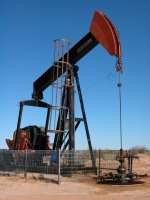FIP
 Over at the Oil Drum, they've done a very nice and extensive analysis of "fields in production" (FIP) for Exxon, the largest of the oil producers. Essentially, they've used Exxon's own numbers to calculate the expected amount of oil production, the actual amount, the cost to increase production, and then compared that to Exxon CEO Lee Raymond's ongoing optimistic predictions.
Over at the Oil Drum, they've done a very nice and extensive analysis of "fields in production" (FIP) for Exxon, the largest of the oil producers. Essentially, they've used Exxon's own numbers to calculate the expected amount of oil production, the actual amount, the cost to increase production, and then compared that to Exxon CEO Lee Raymond's ongoing optimistic predictions.The whole post is a good read. But if you want to forego the graphs and math, here's the key graf:
Clearly, the bulk of Exxon's failure to grow their supply as they hoped does not come from project delays, but rather than from somewhat underestimating the decline rate in their existing fields. Indeed, for the last eight years, all of the very considerable new capacity that Exxon has bought on at great expense and enormous trouble has only gone to offset declines. They have not managed to grow their production or market share one iotaIn a nutshell, older fields are slowing in production and the rate of new fields coming on line is not keeping up. The estimated rate of decline is around 8%. If true they conclude:
As those of you following my analysis of the relationship between miles travelled and GDP know, I'm pretty convinced the US economy can't save very much absolute oil usage without economic growth being hurt - we can only make the economy less oil intensive at 3%-4% annually....If these estimates are true, it suggests that a gradual adaptation to peak oil is not going to occur without pain. The rate of decline is simply higher than the historic rate of adaptation.
Granted, there are a lot of if's in this scenario. But it's just a tiny bit piled on a growing mountain of evidence that a government sponsored, highly proactive movement away from a petroleum economy is essential.
0 Comments:
Post a Comment
<< Home